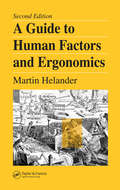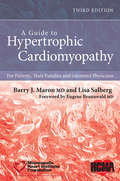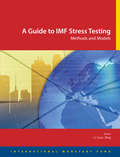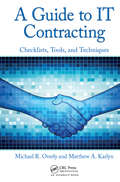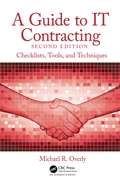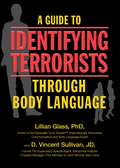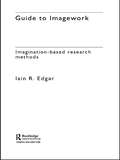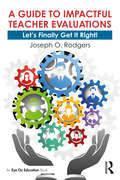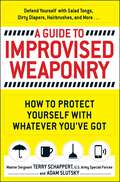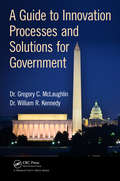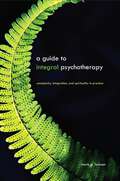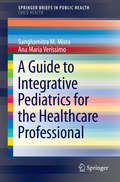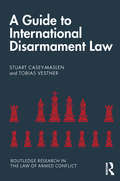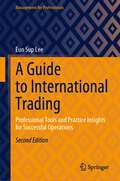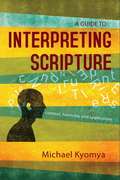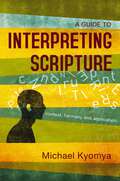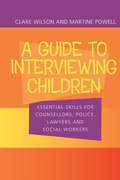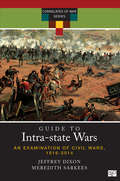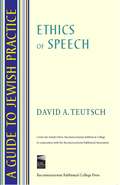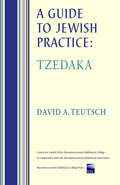- Table View
- List View
A Guide to Human Factors and Ergonomics
by Martin HelanderCompletely revised and updated, A Guide to Human Factors and Ergonomics, Second Edition presents a comprehensive introduction to the field. Building on the foundation of the first edition, titled Guide to Ergonomics of Manufacturing, the new title reflects the expanded range of coverage and applicability of the techniques you will fin
A Guide to Hypertrophic Cardiomyopathy
by Barry J. Maron Lisa SalbergWritten by the authority on hypertrophic cardiomyopathy (HCM) and an HCM patient, and fully endorsed by the Hypertrophic Cardiomyopathy Association (HCMA), the leading advocacy and support organization, the 3rd Edition of this best-selling guide offers unparalleled insight into all aspects of living with and treating HCM.Accessible and practical, A Guide to Hypertrophic Cardiomyopathy For Patients, Their Families and Interested Physicians 3rd Edition:Answers the most pressing questions posed by patients, their families, and non-specialistshealth professionals involved in their careCovers everything from what is HCM and initial diagnosis of this increasingly prevalentcondition to the latest treatment optionsReflects the first-ever HCM guidelines published by the American Heart Association in 2011
A Guide to IMF Stress Testing: Methods and Models
by Li Lian OngA report from the International Monetary Fund.
A Guide to IT Contracting: Checklists, Tools, and Techniques
by Michael R. Overly Matthew A. KarlynEven leading organizations with sophisticated IT infrastructures and teams of lawyers can find themselves unprepared to deal with the range of issues that can arise in IT contracting. Written by two seasoned attorneys, A Guide to IT Contracting: Checklists, Tools, and Techniques distills the most critical business and legal lessons learned through
A Guide to IT Contracting: Checklists, Tools, and Techniques
by Michael R. OverlySince A Guide to IT Contracting: Checklists, Tools, and Techniques first published, several alarming trends have developed in the technology contracting industry. These trends include: The Dawn of the "As-Is" Technology Product The Ever-Changing Product Where in the World Is My Data? To meet these challenges, the Second Edition helps business managers and lawyers explore alternate solutions from other vendors, conduct simultaneous negotiations with other vendors, and, generally, ensure prospective vendors understand they can "lose the deal" if they refuse to act reasonably. Distilling the most critical business and legal lessons learned through the author’s decades of legal experience drafting and negotiating IT-related agreements, this single volume lets readers quickly access information on virtually every type of technology agreement. Structured to focus on a particular type of IT agreement, each chapter includes a checklist of essential terms, a brief summary of what the agreement is intended to do, and a complete review of the legal and business issues that are addressed in that particular agreement. Providing nonlegal professionals with the tools to address IT contracting issues, the book: Contains checklists to help readers organize key concepts for ready reference Supplies references to helpful online resources and aids for contract drafting Includes a complete glossary that defines key legal, business, and technical terms Technology contracting is becoming ever more difficult. This book is filled with recommendations to mitigate potential risk and makes clear the importance of maintaining negotiating leverage with potential vendors.
A Guide to Identifying Terrorists Through Body Language
by Lillian Glass D. Vincent Sullivan JDIt's not just Osama Bin Laden anymore.It's the people all around you - from coworkers to your next-door neighbor. From domestic terrorists and serial killers to troubled students and homicidal exes, violent people are living right here among us. But we don't have to count on patience and providence to get us through. In A Guide to Identifying Terrorists Through Body Language, renowned body-language expert and bestselling Toxic People author Dr. Lillian Glass reveals the visual cues, characteristics, and behaviors we need to identify the most dangerous people in our midst - in only seconds. In this book she teams up with former FBI Special Agent D. Vincent Sullivan where they both draw upon decades of experience. Her expertise in body language, vocal forensics, and behavioral analysis, and his experience as a former member of the Joint Terrorist Task Force provide you with the the same instruction, information, and insight they have provided to law enforcement, the justice system, and Homeland Security, among others. Complete with real-life scenarios and case studies, this groundbreaking handbook is the protection we upstanding citizens need to keep ourselves, our families, and our society free from harm.
A Guide to Identifying Terrorists Through Body Language
by Lillian GlassIt’s not just Osama Bin Laden anymore.It’s the people all around you - from coworkers to your next-door neighbor. From domestic terrorists and serial killers to troubled students and homicidal exes, violent people are living right here among us.But we don’t have to count on patience and providence to get us through. In A Guide to Identifying Terrorists Through Body Language, renowned body-language expert and bestselling Toxic People author Dr. Lillian Glass reveals the visual cues, characteristics, and behaviors we need to identify the most dangerous people in our midst - in only seconds. In this book she teams up with former FBI Special Agent D. Vincent Sullivan where they both draw upon decades of experience. Her expertise in body language, vocal forensics, and behavioral analysis, and his experience as a former member of the Joint Terrorist Task Force provide you with the the same instruction, information, and insight they have provided to law enforcement, the justice system, and Homeland Security, among others. Complete with real-life scenarios and case studies, this groundbreaking handbook is the protection we upstanding citizens need to keep ourselves, our families, and our society free from harm.
A Guide to Imagework: Imagination-Based Research Methods
by Iain EdgarA Guide to Imagework is a pioneering guide to a new trend in ethnographic research: the use of imaginative, experiential methods such as dreamwork, artwork, Gestalt theory and psychodrama. Originating in group counselling and psychiatric therapy, imagework techniques explore subjects' imaginative resources to reveal unconscious knowledge about identity, belief and society. They are ideal for accessing rich qualitative data about how individuals and cultures function. Iain Edgar, a leading specialist on ethnographic method, has condensed top-level research theory on imagework into this handy practical manual. Complete with case studies and examples, hands-on tips and guidance on methods and ethics, it is an ideal starting point for any imagework project.
A Guide to Impact Fees and Housing Affordability
by Arthur C. Nelson Liza K. Bowles James C. Nicholas Craig Anthony Arnold Julian C. Juergensmeyer Dwight MerriamImpact fees are one-time charges that are applied to new residential developments by local governments that are seeking funds to pay for the construction or expansion of public facilities, such as water and sewer systems, schools, libraries, and parks and recreation facilities. In the face of taxpayer revolts against increases in property taxes, impact fees are used increasingly by local governments throughout the U.S. to finance construction or improvement of their infrastructure. Recent estimates suggest that 60 percent of all American cities with over 25,000 residents use some form of impact fees. In California, it is estimated that 90 percent of such cities impose impact fees. For more than thirty years, impact fees have been calculated based on proportionate share of the cost of the infrastructure improvements that are to be funded by the fees. However, neither laws nor courts have ensured that fees charged to new homes are themselves proportionate. For example, the impact fee may be the same for every home in a new development, even when homes vary widely in size and selling price. Data shows, however, that smaller and less costly homes have fewer people living in them and thus less impact on facilities than larger homes. This use of a flat impact fee for all residential units disproportionately affects lower-income residents.The purpose of this guidebook is to help practitioners design impact fees that are equitable. It demonstrates exactly how a fair impact fee program can be designed and implemented. In addition, it includes information on the history of impact fees, discusses alternatives to impact fees, and summarizes state legislation that can influence the design of local fee programs.This book should be the first place planning professionals, public officials, land use lawyers, developers, homebuilders, and citizen activists turn for help in crafting (or recrafting) proportionate-share impact fee programs.
A Guide to Impactful Teacher Evaluations: Let's Finally Get It Right!
by Joseph O. RodgersWhat if everything we thought we knew about effective teacher evaluations was wrong? A Guide to Impactful Teacher Evaluations walks educators through an important shift in thinking about how to evaluate teachers: from systems focused on individuals and results to solutions focused on collectives and processes. Disregarding older, ineffective models that rely on faulty assumptions, this book embraces new approaches for measuring teacher competency that achieve valid assessment of effective teaching, teacher professional growth, and student learning. Chapters explore teacher evaluation systems based on professional learning community principles, confront the current system of teacher evaluation that has led to frustration, criticism, and disrespect, provide strategies for delivering new skills and supporting teachers’ growth, and include "Tips and Talking Points" for schools and districts. Outlining best practice and sharing actionable tools grounded in collaboration and teamwork, this book helps K-12 school leaders explore teacher evaluation that has a real and lasting impact on the profession and student learning.
A Guide to Implementing MLOps: From Data to Operations (Synthesis Lectures on Engineering, Science, and Technology)
by Prafful MishraOver the past decade, machine learning has come a long way, with organisations of all sizes exploring its potential to extract valuable insights from data. However, despite the promise of machine learning, many organisations need help deploying and managing machine learning models in production. This is where MLOps comes in. MLOps, or machine learning operations, is an emerging field that focuses on the deployment, management, and monitoring of machine learning models in production environments. MLOps combines the principles of DevOps with the unique requirements of machine learning, enabling organisations to build and deploy models at scale while maintaining high levels of reliability and accuracy. This book is a comprehensive guide to MLOps, providing readers with a deep understanding of the principles, best practices, and emerging trends in the field. From training models to deploying them in production, the book covers all aspects of the MLOps process, providing readers with the knowledge and tools they need to implement MLOps in their organisations. The book is aimed at data scientists, machine learning engineers, and IT professionals who are interested in deploying machine learning models at scale. It assumes a basic understanding of machine learning concepts and programming, but no prior knowledge of MLOps is required. Whether you're just getting started with MLOps or looking to enhance your existing knowledge, this book is an essential resource for anyone interested in scaling machine learning in production.
A Guide to Improvised Weaponry: How to Protect Yourself with WHATEVER You've Got
by Adam Slutsky Terry SchappertDefend yourself with salad tongs, hairbrushes--and even a dirty diaper!A sidewalk thief tries to steal your wallet, but you are unarmed. What do you do? With A Guide to Improvised Weaponry, you'll know how to protect yourself--even if all you have are your car keys and a candy bar. Written by Green Beret and combat expert Terry Schappert, this book teaches you how to turn your lipstick, your wristwatch--even the shoes on your feet--into strategic self-defense tools. Traditional weapons can be expensive, dangerous, and in the blur of an attack, easily turned against you, but with his life-saving advice, you can avoid these risks and defend yourself by deploying the hidden tactical uses of 100 ordinary items.Whether you're out grocery shopping, riding in an elevator, or enjoying a stroll through the park, A Guide to Improvised Weaponry shows you how to control your environment and become your own bodyguard--ready and able to act when you need to.
A Guide to In-sessional English for Academic Purposes: Paradigms and Practices
by Neil Adam Tibbetts Timothy ChapmanA hands-on guide for practitioners, this book prepares instructors to teach in-sessional English for Academic Purposes (ISEAP) higher education courses. As university cohorts become more diverse, there is demand for in-sessional EAP courses not only to support international students, but also increasingly as a provision for all students. This informative resource explores the varying formats of ISEAP courses and how they are embedded within and alongside students’ degree programmes in the United Kingdom and beyond. In accessible chapters, authors Neil Adam Tibbetts and Timothy Chapman present illuminating findings drawn from interviews conducted with experts in the field and highlight the challenges that students and practitioners face. Avoiding prescriptive recommendations, Tibbetts and Chapman address different models and contexts of ISEAP courses at the university level and offer guidance and tools for practice. Covering key topics such as pedagogies, logistical challenges, and the wider university context, this book not only provides a roadmap to the often ill-defined but essential domain of ISEAP but also provokes questions and ideas for further reflection, guiding the reader towards a deeper understanding of their role and development in context. Engaging and inviting, Tibbetts and Chapman’s helpful text is a necessary resource for teachers to design and lead successful ISEAP courses.
A Guide to Innovation Processes and Solutions for Government
by Gregory C. McLaughlin DBA William R. Kennedy DBAThis book provides a roadmap for successful implementation of innovation for organizations working as subcontractors or suppliers for the federal government. With a focus on the federal sector, it details tools and processes that can make significant improvements in how the federal sector handles innovation opportunities. Presenting insights that can help readers bridge the gap between supplier and customer, the book includes many examples and a case study that illustrate the application of the methodology. It also includes process flowcharts, tools, and strategies for innovation within an agency or organization.
A Guide to Integral Psychotherapy: Complexity, Integration, and Spirituality in Practice (SUNY series in Integral Theory)
by Mark D. FormanThis book provides a practical introduction to Integral Psychotherapy, which positions itself as the most comprehensive approach to psychotherapy yet offered. Grounded in the work of theoretical psychologist and philosopher Ken Wilber, it organizes the key insights and interventions of pharmacological, psychodynamic, behavioral, cognitive, humanistic, existential, feminist, multicultural, somatic, and transpersonal approaches to psychotherapy. Integral Psychotherapy does not attempt to unify these diverse models, but rather takes a metatheoretical perspective, giving general guidelines for which is most appropriate in a wide range of clinical situations. It also strongly emphasizes the therapist's own personal development, under the premise that the depth and complexity of the human psyche must be understood first within the self if it is to be understood fully in others. This essential text is for therapists and others drawn to holistic approaches to psychotherapy, and serves as a theoretical ground and precise guide for those interested in applying the Integral model in therapeutic practice.
A Guide to Integrative Pediatrics for the Healthcare Professional (SpringerBriefs in Public Health #0)
by Sanghamitra M. Misra Ana Maria VerissimoIn response to the rise in chronic medical conditions--and the growing use of complementary and alternative therapies--among pediatric and adolescent patients, healthcare practitioners are taking a serious look at pediatric integrative medicine (PIM). Although it dovetails with current concepts of preventive medicine, wellness, and patient control, PIM is still an evolving field with its own particular challenges and opportunities. A Guide to Integrative Pediatrics for the Healthcare Professional explores its subject through the more familiar lens of integrative medicine. This concise comprehensive resource synthesizes the knowledge base on a range of therapies commonly associated with PIM, such as acupuncture, herbal remedies, clinical hypnosis, yoga, homeopathy, and therapeutic massage, with findings on their effective use with children. Case examples illustrate uses of PIM modalities with allopathic medicine to treat young patients at various developmental stages, and the authors pinpoint safety and appropriateness concerns, answer licensing questions, and note clinical areas requiring further study. The wide-ranging information contained here will help support interest in PIM at the research, training, and practice levels. Features of the Guide: An introduction to basic concepts in PIM. Trends in IM/PIM education. A survey of complementary and alternative therapies, including biologically-based, body-based, mind-body, energy-based, and alternative whole systems. Current evidence for IM in treating common pediatric conditions. The future of integrative pediatrics. References and links for further information. Offering a front-row seat to the continued expansion of the field, A Guide to Integrative Pediatrics for the Healthcare Professional is a salient text not only for pediatricians but for all healthcare practitioners tasked with improving children's wellbeing.
A Guide to International Disarmament Law (Routledge Research in the Law of Armed Conflict)
by Stuart Casey-Maslen Tobias VestnerDisarmament is integral to the safeguarding and promotion of security, development, and human rights. Hundreds of millions of dollars are spent each year on disarmament operations, yet no comprehensive guide exists to explain clearly the international rules governing disarmament. This book seeks to fill that gap. It describes the international legal rules that govern disarmament and the operational, political, and technical considerations that govern their implementation. This book aims to support compliance, implementation, and further development of international disarmament law. Traditionally, disarmament focused on weapons of mass destruction. This remains a critically important area of work. In recent decades, the scope of disarmament has broadened to encompass also conventional weapons, including through the adoption of rules and regulations to govern arms transfers and measures to eliminate specific munitions from stockpiles and to destroy explosive remnants of war. There have also been four "generations" of programmes to address small arms and light weapons at national or sub-national level through disarmament, demobilisation, and reintegration (DDR) programmes during and following the end of armed conflict. While an internationally accepted definition of disarmament does not yet exist, it is widely agreed that disarmament encompasses or interrelates with prohibitions and restrictions on the development, production, stockpiling, testing, and transfer of weapons and on their destruction. In addition to clarifying these elements, chapters of this guide will also consider the relationship between disarmament and the law of armed conflict, and with the United Nations Security Council, human security, public health, and non-state actors.
A Guide to International Trading: Professional Tools and Practice Insights for Successful Operations (Management for Professionals)
by Eun Sup LeeThis book offers a practical guide for successful international trade operations. Written for MBA students and professionals, it provides tools and best practices for managing and operating complex international trade transactions. Readers learn about the legal, administrative, and practical aspects of international business transactions and how to gather and manage the proper information needed. The book covers topics such as public and private regulation of international trade, overseas market research, international trade terms, international trade contracts, payment collection, international transportation, marine cargo insurance, exchange rate risk, electronic commerce, and claims and dispute resolution. It is a valuable resource for both business students and professionals involved in international trade or export businesses.
A Guide to Interpreting Scripture: Context, Harmony, and Application
by Michael KyomyaAccording to Dr. Michael Kyomya, misconceptions about what the Bible actually says can breed confusion and false ideas about God and the Christian life. Therefore, it is critically important that you know how to interpret Scripture carefully. Dr. Michael Kyomya explains what interpretation is, why it is important, how to do it, and the pitfalls to avoid. He illustrates his points with examples from his own experience and from sermons he has heard in Africa. Dr. Kyomya makes it clear that interpretation is not just something for scholars, but also is useful when preparing a sermon or a Sunday school lesson, as well as in your own personal study of the Bible. The writing is simple and clear, and the illustrations are both amusing and informative. Full of ways to enrich personal study of the Bible, this guide will equip you with the knowledge and instruction you need.
A Guide to Interpreting Scripture: Context, Harmony, and Application (Hippo Ser.)
by Michael KyomyaAccording to Dr. Michael Kyomya, misconceptions about what the Bible actually says can breed confusion and false ideas about God and the Christian life. Therefore, it is critically important that you know how to interpret Scripture carefully. Dr. Michael Kyomya explains what interpretation is, why it is important, how to do it, and the pitfalls to avoid. He illustrates his points with examples from his own experience and from sermons he has heard in Africa. Dr. Kyomya makes it clear that interpretation is not just something for scholars, but also is useful when preparing a sermon or a Sunday school lesson, as well as in your own personal study of the Bible. The writing is simple and clear, and the illustrations are both amusing and informative. Full of ways to enrich personal study of the Bible, this guide will equip you with the knowledge and instruction you need.
A Guide to Interviewing Children: Essential Skills for Counsellors, Police Lawyers and Social Workers
by Claire Wilson Martine PowellChildren may be witnesses to crimes or accidents, or suspected victims of abuse or neglect, or they may be involved in some form of legal action such as custody cases. In these situations, they may need to be interviewed formally, and if this is not done properly, incorrect or inadequate information may be recorded or the child's position may not be correctly represented later in court. In cases of child abuse, the child may not be the only witness, and the quality of their verbal evidence is critical.A Guide to Interviewing Children is a practical guide the evidential interviewing techniques needed by a range of professionals: social workers, forensic psychologists, lawyers, police and teachers. It outlines basic techniques, explains how to deal with children of different ages (from pre-school to fifteen years), how to deal with parents, the particular issues of sexual abuse, handling multiple interviews of one child and so on. It is written for an international readership, and will be more practical and cover a broader range of contexts than the other titles currently available.
A Guide to Intra-state Wars: An Examination of Civil, Regional, and Intercommunal Wars, 1816-2014
by Jeffrey S. Dixon Meredith Reid SarkeesSourcing data and analyses from the rigorous Correlates of War Project, A Guide to Intra-state Wars describes how civil war is defined and categorized and presents data and descriptions for nearly 300 civil wars waged from 1816 to 2014. Analyzing trends over time and regions, this work is the definitive source for understanding the phenomenon of civil war, bringing together an explanation of the theoretical premises driving the Correlates of War Project, along with revisions to categories of, and actors in, civil wars that have been made over the years, and data from the Nations, States and Entities civil war dataset. Features: Provides detailed case studies of nearly 300 civil wars from 1816 to 2014. Combines the systematic study of war with analyses of trends over time and regions. Includes discussion of the different types of actors in international relations and presents data from the Nations, States, and Entities dataset. Considers data describing non-state participants (rebels) in civil wars.
A Guide to Intra-state Wars: An Examination of Civil, Regional, and Intercommunal Wars, 1816-2014
by Jeffrey S. Dixon Meredith Reid SarkeesSourcing data and analyses from the rigorous Correlates of War Project, A Guide to Intra-state Wars describes how civil war is defined and categorized and presents data and descriptions for nearly 300 civil wars waged from 1816 to 2014. Analyzing trends over time and regions, this work is the definitive source for understanding the phenomenon of civil war, bringing together an explanation of the theoretical premises driving the Correlates of War Project, along with revisions to categories of, and actors in, civil wars that have been made over the years, and data from the Nations, States and Entities civil war dataset. Features: Provides detailed case studies of nearly 300 civil wars from 1816 to 2014. Combines the systematic study of war with analyses of trends over time and regions. Includes discussion of the different types of actors in international relations and presents data from the Nations, States, and Entities dataset. Considers data describing non-state participants (rebels) in civil wars.
A Guide to Jewish Practice: Ethics of Speech
by David A. TeutschThe way we use speech can build or destroy our communities. Language may be the most powerful single tool that contemporary people have. This volume provides a moral framework for using that tool.
A Guide to Jewish Practice: Tzedaka
by David A. TeutschShifting attitudes and practices in the Jewish philanthropic here have resulted in a call for deeper thinking about the by and how of charitable giving. This slim volume responds to that call...
